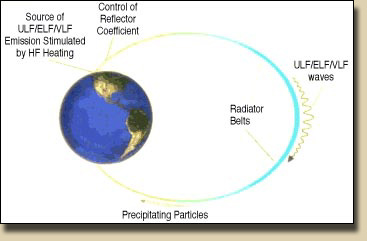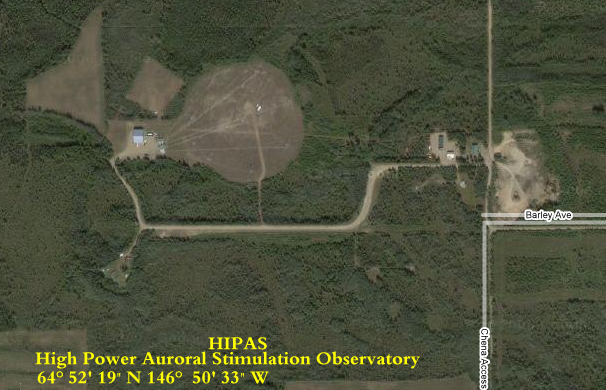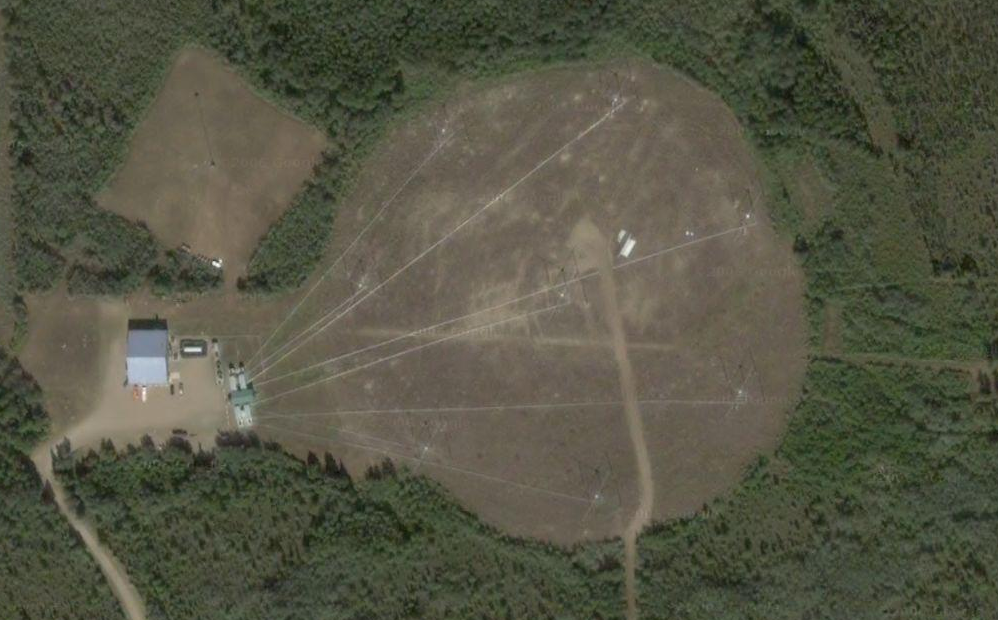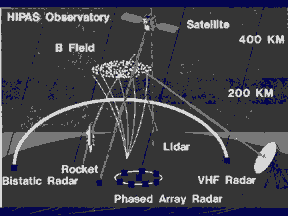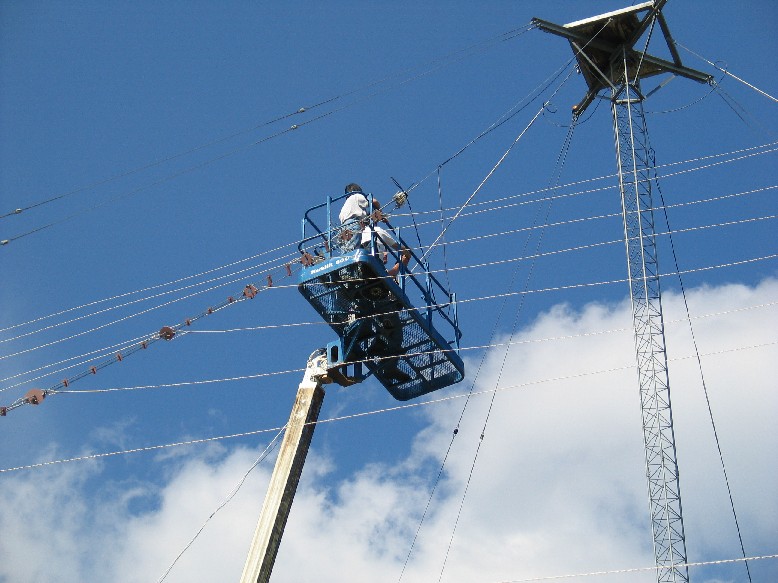|
High Power Auroral Stimulation Observatory |
|||||||||
|
Fairbanks Alaska 64° 52' 19" N 146° 50' 33" W ..
|
|||||||||
|
HIPAS is
located 30 miles Northeast of Fairbanks
Alaska; in the small community of Two Rivers. It
occupies 120 acres of
land and has six buildings.
The facility is located at: latitude
and longitude.
The facility operates year-round. The HIPAS facility is engaged in the study of the Ionosphere through the use of high power radio transmission as well as a state-of-the-art LIDAR (LIght Detection And Ranging ) facility. The Heater system consists of 8 transmitters capable of conducting amplitude modulation of 100 Hz - 20 kHz and phase modulation of 0 -20 kHz. Each transmitter can transmit up to 150kW at 2.85 or 4.53 MHz on CW mode. The Heater antenna system consists of a circular array of 8 crossed dipoles, copper wire ground-planes and resonant triaxial baluns. The LIDAR facility consists of a 2.7 meter LMT (Liquid Mirror Telescope) with a 4.5 meter focal length as well as 6 state-of-the-art lasers. Hipas Observatory Mission Statement: History: The University of California at Los Angeles (UCLA), Plasma Physics Laboratory (PPL), has, over the last twenty years, established an ionospheric research observatory near Fairbanks, Alaska (at 64o 52' 19" N latitude and 146o 50' 33" W longitude. Known as HIPAS (for HIgh Power Auroral Stimulation), the main feature of the observatory is a one million Watt (1MW), 8 antenna array of 70 MW effective radiated power (ERP), broadcasting essentially vertically at either 2.85 MHz (second harmonic of the electron gyro frequency in the earth's field at 150 km altitude) or at 4.53 MHz.1. This Radio Frequency (RF) ionospheric heater has been shown to modify the conductivity of the ionosphere for the purposes of generating Extra Low Frequency (ELF) electromagnetic waves (for underwater and underground communication purposes), Stimulated Electromagnetic Emissions (SEE), plasma density cavities, etc. Successes with HIPAS resulted in the construction of a second Ionospheric research facility, 288 km to the south east (called HAARP, for High-frequency Active Auroral Research Project), with the same total radiated power as HIPAS, but slightly higher ERP due to its more closely packed 48 element antenna array. HAARP can be continuously tuned between 3.1 -9 MHz, for the purpose of matching the transmitter's frequency to the ionosphere's plasma frequency (wpe2= 4pnee2/me) at some altitude. Such matching by either HAARP or HIPAS sets up standing electro magnetic (E&M) waves that couple RF power into the ionosphere, heating it, and changing the local conductivity generating ELF, SEE, and plasma glow. Both sites have radio frequency and optical diagnostics that include Ionosondes, radio frequency receivers, imaging photometers, etc. HIPAS is the only one with a LIDAR. The HIPAS LIDAR is unique due to the size of its optical collector, a 2.7 m diameter Liquid Mirror Telescope (LMT). SOURCE:
HIPAS
Home Page
|
|||||||||
| HIPAS
Observatory
The HIPAS (HIgh Power Auroral Stimulation) Observatory is an ionospheric heater, which can radiate 70 MW ERP at either 2.85 MHz or 4.53 MHz. located 30 miles Northeast of Fairbanks, Alaska, in the small community of Two Rivers. It is located at: 64° 52’ 19" N latitude and 146° 50’ 33" W longitude and operates year-round. The HIPAS Observatory is operated by the UCLA plasma physics laboratory. The HIPAS facility is engaged in the study of the ionosphere through the use of high power radio transmission as well as a LIDAR (LIght Detection And Ranging ) instrument. The facility is home to several projects with some interesting equipment, including:
SOURCE: Wikipedia
HIPAS
Observatory |
|||||||||
| Related Links:
Papers:
|
|||||||||
| HIPAS
Observatory
UCLA Physics Plasma Lab The nearly vertical magnetic field lines connect the location to both the magnetosphere and the open field lines HIPAS Observatory is on a 120 acre site located about 25 miles east of Fairbanks on the Chena-Hot Springs road. there are 6 buildings (~10,000 sq ft), and remotely operated diagnostic at off-site locations.One of the buildings is a "bunkhouse," available to provide housing for visiting experimenters. The site operates year-round. Professor Alfred Y. Wong is the director and Dr. Ralph Wuerker is the associate director. There are four permanent staff members. Mr. William Huhn is the site manager. The site is owned by the University of Alaska, Fairbanks, which cooperates with UCLA. HIPAS is one of the best locations for the observation of the Auroral Borealis HIPAS has several diverse experimental facilities: a 1-megawatt rf transmitter to produce ELF/VLF (Extremely Low and Very Low Frequency) electromagnetic (EM) generation by the absorption of radio Frequency (rf) power in the artic ionospher including ion cyclotron excitation; a 100 kW rf plasma torch used in research on the destruction of hazardous waste; a 2.7 m liquid mirror telescope used with one of several lasers for ionospheric stimulation and measurement; an Incoherent Scatter Radar (a new project using 88 ft. diameter antenna at NOAA Gilmore Creek site 34 km SW of HIPAS as the receiving antenna with the transmitter at HIPAS). We are in the process of adding a very high power (terawatt) laser (recently obtained from LLNL) to perform laser breakdown experiments in the ionosphere. Two Diesel electric generators (1500 HP 4160 V, 3-phase, _1.2 MVA each) are used to power the experiments. there are a number of computers (PC's ) on site, and a high-speed data line to UAF is available. Over the last 20 years HIPAS Observatory has built up a spectrum of communication frequencies from very low to very high ELF (Extremely Low Frequncies) to laser frequencies.
SOURCE: UCLA Physics Plasma Lab |
|||||||||
|
.. Credit: HIPAS Contact: Webmaster@hipas.alaska.edu ... Credit: HIPAS Contact: Webmaster@hipas.alaska.edu ... Credit: HIPAS Contact: Webmaster@hipas.alaska.edu ... Credit: HIPAS Contact: Webmaster@hipas ...
Credit: HIPAS Contact: Webmaster@hipas.alaska.edu ... Credit: HIPAS Contact: Webmaster@hipas.alaska.edu ... Credit: HIPAS Contact: Webmaster@hipas.alaska.edu ... |
|||||||||
|
.. Credit: HIPAS Contact: Webmaster@hipas.alaska.edu ... Credit: HIPAS Contact: Webmaster@hipas.alaska.edu ... Credit: HIPAS Contact: Webmaster@hipas.alaska.edu ... Credit: HIPAS Contact: Webmaster@hipas ... Credit: HIPAS Contact: Webmaster@hipas.alaska.edu ... Credit: HIPAS Contact: Webmaster@hipas.alaska.edu ... Credit: HIPAS Contact: Webmaster@hipas.alaska.edu |
|||||||||
|
.. Credit: HIPAS Contact: Webmaster@hipas.alaska.edu ... Credit: HIPAS Contact: Webmaster@hipas.alaska.edu ... Credit: HIPAS Contact: Webmaster@hipas.alaska.edu ... Credit: HIPAS Contact: Webmaster@hipas ... Credit: HIPAS Contact: Webmaster@hipas.alaska.edu ... Credit: HIPAS Contact: Webmaster@hipas.alaska.edu ... Credit: HIPAS Contact: Webmaster@hipas.alaska.edu ... Credit: HIPAS Contact: Webmaster@hipas.alaska.edu ... Credit: HIPAS Contact: Webmaster@hipas.alaska.edu |
|||||||||
| FAIR USE NOTICE: This page contains copyrighted material the use of which has not been specifically authorized by the copyright owner. Pegasus Research Consortium distributes this material without profit to those who have expressed a prior interest in receiving the included information for research and educational purposes. We believe this constitutes a fair use of any such copyrighted material as provided for in 17 U.S.C ? 107. If you wish to use copyrighted material from this site for purposes of your own that go beyond fair use, you must obtain permission from the copyright owner. | |||||||||
|
|
